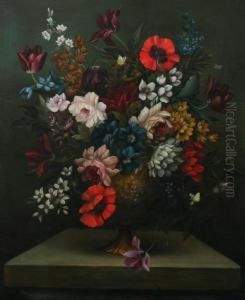Jacob Van Doost Paintings
Jacob Van Doost, also known as Jacob Willemsz van Doordt, was a Dutch Golden Age painter born in 1630 in Leiden, Netherlands. Although not as widely recognized as some of his contemporaries, Van Doost made significant contributions to the art world of his time, particularly in the genre of portrait painting. His work reflects the rich cultural and artistic atmosphere of the Dutch Golden Age, a period marked by great wealth and a booming art market in the Netherlands.
Van Doost trained under the guidance of prominent artists of his time, which was a common practice for aspiring painters. He developed a style characterized by meticulous attention to detail, rich coloration, and a keen ability to capture the emotional depth and personality of his subjects. Van Doost's portraits are notable for their realism and the subtle interplay of light and shadow, a testament to his skill in manipulating paint to achieve lifelike results.
Throughout his career, Van Doost found patronage among the Dutch elite, producing portraits and occasional genre scenes. His works were sought after by wealthy merchants, civic leaders, and aristocrats, who desired to have their likenesses captured for posterity. Despite his success, detailed records of his life and works are sparse, and many of his paintings have been attributed to him only through stylistic analysis and comparison with his few signed and documented works.
Jacob Van Doost passed away in 1686 in his hometown of Leiden. His legacy, though somewhat overshadowed by the more famous names of his era, remains integral to the understanding of Dutch portraiture in the 17th century. Today, his works are held in various collections and museums, offering insight into the craftsmanship and aesthetic concerns of the period. His contributions continue to be studied by art historians and appreciated by art lovers for their beauty and historical significance.
